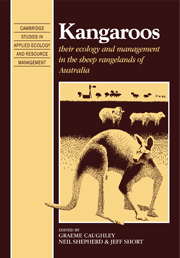Crossref Citations
This Book has been
cited by the following publications. This list is generated based on data provided by Crossref.
WALKER, P. A.
and
MOORE, D. M.
1988.
SIMPLE An inductive modelling and mapping tool for spatially-oriented data.
International journal of geographical information systems,
Vol. 2,
Issue. 4,
p.
347.
Henle, Klaus
1989.
Population ecology and life history of the diurnal skink Morethia boulengeri in arid Australia.
Oecologia,
Vol. 78,
Issue. 4,
p.
521.
Henle, Klaus
1991.
Life history patterns in lizards of the arid and semiarid zone of Australia.
Oecologia,
Vol. 88,
Issue. 3,
p.
347.
Ellis, Jim
and
Galvin, Kathleen A.
1994.
Climate Patterns and Land-Use Practices in the Dry Zones of Africa.
BioScience,
Vol. 44,
Issue. 5,
p.
340.
EDWARDS, G. P.
DAWSON, T. J.
and
CROFT, D. B.
1995.
The dietary overlap between red kangaroos (Macropus rufus) and sheep (Ovis aries) in the arid rangelands of Australia.
Australian Journal of Ecology,
Vol. 20,
Issue. 2,
p.
324.
EDWARDS, G. P.
CROFT, D. B.
and
DAWSON, T. J.
1996.
Competition between red kangaroos (Macropus rufus) and sheep (Ovis aries) in the arid rangelands of Australia.
Australian Journal of Ecology,
Vol. 21,
Issue. 2,
p.
165.
Gould, Richard A.
1996.
Faunal reduction at Puntutjarpa rockshelter, Warburton Ranges, Western Australia.
Archaeology in Oceania,
Vol. 31,
Issue. 2,
p.
72.
Mate, K.E.
Molinia, F.C.
and
Rodger, J.C.
1998.
Manipulation of the fertility of marsupials for conservation of endangered species and control of over-abundant populations.
Animal Reproduction Science,
Vol. 53,
Issue. 1-4,
p.
65.
Puigdefábregas, J.
1998.
Ecological impacts of global change on drylands and their implications for desertification.
Land Degradation & Development,
Vol. 9,
Issue. 5,
p.
393.
Hone*, Jim
1999.
On rate of increase (r): patterns of variation in Australian mammals and the implications for wildlife management.
Journal of Applied Ecology,
Vol. 36,
Issue. 5,
p.
709.
Bergman, C. M.
Fryxell, J. M.
and
Gates, C. C.
2000.
The effect of tissue complexity and sward height on the functional response of Wood Bison.
Functional Ecology,
Vol. 14,
Issue. 1,
p.
61.
Brockington, Dan
and
Homewood, Katherine
2001.
Degradation Debates and Data Deficiencies: The Mkomazi Game Reserve, Tanzania.
Africa,
Vol. 71,
Issue. 3,
p.
449.
Sullivan, Sian
and
Rohde, Rick
2002.
On non‐equilibrium in arid and semi‐arid grazing systems.
Journal of Biogeography,
Vol. 29,
Issue. 12,
p.
1595.
Grierson, I. T.
and
Gammon, J. A.
2002.
The Use of Aerial Digital Imagery for Kangaroo Monitoring.
Geocarto International,
Vol. 17,
Issue. 2,
p.
45.
Sibly, R. M.
Hone, J.
Clutton–Brock, T. H.
Sinclair, A. R. E.
and
Krebs, Charles J.
2002.
Complex numerical responses to top–down and bottom–up processes in vertebrate populations.
Philosophical Transactions of the Royal Society of London. Series B: Biological Sciences,
Vol. 357,
Issue. 1425,
p.
1221.
Dexter, N.
2003.
Stochastic models of foot and mouth disease in feral pigs in the Australian semi‐arid rangelands.
Journal of Applied Ecology,
Vol. 40,
Issue. 2,
p.
293.
Gruber, Bernd
and
Henle, Klaus
2004.
Linking habitat structure and orientation in an arboreal species Gehyra variegata (Gekkonidae).
Oikos,
Vol. 107,
Issue. 2,
p.
406.
Price, Kevin
Yu, Fangfang
Lee, Re-Yang
and
Ellis, James
2004.
Characterizing Ecosystem Variability Using the Onset of Green-Up Derived from Time-Series AVHRR NDVI Data.
GIScience & Remote Sensing,
Vol. 41,
Issue. 1,
p.
45.
Wills, Taryn E
Chapman, Thomas W
Mound, Laurence A
Kranz, Brenda D
and
Schwarz, Michael P
2004.
Natural history and description ofOncothrips kinchega, a new species of gall‐inducing thrips with soldiers (Thysanoptera: Phlaeothripidae).
Australian Journal of Entomology,
Vol. 43,
Issue. 2,
p.
169.
Hercock, Marion
and
Tonts, Matthew
2004.
From the Rangelands to the Ritz: Geographies of Kangaroo Management and Trade.
Geography,
Vol. 89,
Issue. 3,
p.
214.



